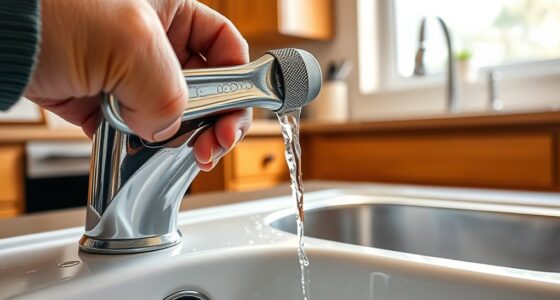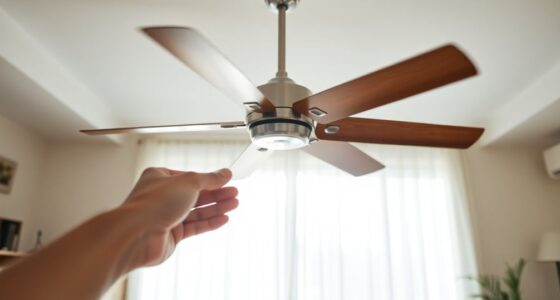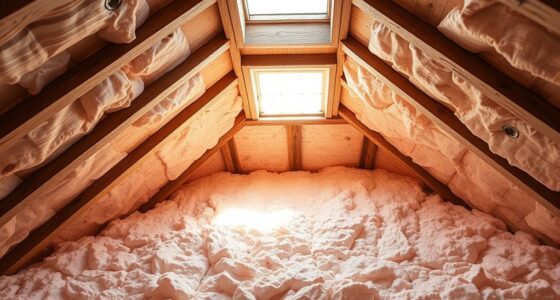Understanding fire extinguisher types is key to keeping your home safe. Each extinguisher works best for specific fire classes: ABC powder for most common fires, CO2 for electrical and flammable liquids, foam for liquids like petrol, wet chemical for kitchen oils, and water for solids like paper. Using the right type prevents hazards and improves safety. To protect your home effectively, learn more about selecting and maintaining these essential devices.
Key Takeaways
- Different fire extinguisher types target specific fire classes: A, B, C, D, and K, for effective safety response.
- ABC powder extinguishers are versatile, suitable for multiple fire types, including solids, liquids, and electrical fires.
- CO2 extinguishers are ideal for electrical and flammable liquid fires, leaving no residue and preventing damage.
- Foam extinguishers effectively suppress flammable liquid fires by creating a barrier and cooling the fuel.
- Proper training, maintenance, and correct placement are essential for safe and effective use of home fire extinguishers.
Understanding Fire Classifications

Fire classifications help you identify the type of fire you’re dealing with, which is vital for selecting the right extinguisher and responding effectively. Understanding fire classification allows you to match the fire with compatible extinguishers, ensuring safety and effectiveness. There are different classes—A, B, C, D, and K—each representing specific fuel sources. For example, Class A involves ordinary combustibles like wood or paper, while Class B covers flammable liquids. Knowing these classifications helps you choose extinguisher compatibility, preventing ineffective use or hazards. Using the wrong extinguisher on a fire can make things worse, so recognizing the fire class is essential. By understanding fire classifications, you can act swiftly and confidently, minimizing damage and enhancing safety during emergencies.
ABC Powder Fire Extinguishers
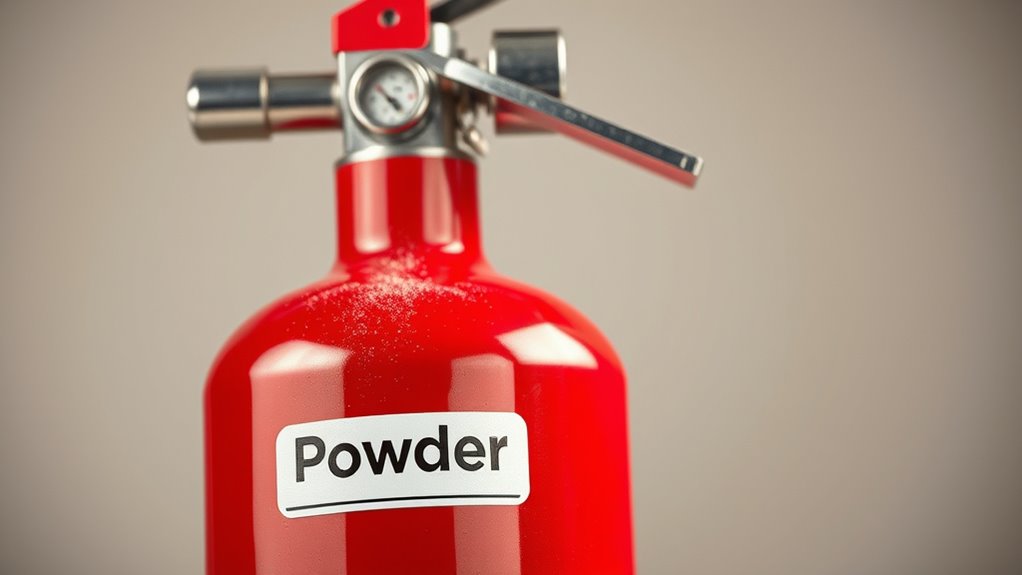
ABC powder fire extinguishers are versatile tools that combine chemicals to fight different fire types effectively. They work well on flammable liquids, electrical fires, and ordinary combustibles, making them a popular choice. Knowing how to use them safely guarantees you can respond quickly and confidently in an emergency. Proper maintenance and regular inspections are essential to ensure the extinguisher functions correctly when needed, especially for fire safety preparedness.
Composition and Effectiveness
Since their development, ABC powder fire extinguishers have become a versatile tool for combating different types of fires. Their primary fire suppressant is a dry chemical mixture composed of monoammonium phosphate, which effectively interrupts the chemical reactions of flames. This extinguishing agent works by smothering the fire and preventing re-ignition. The powder creates a barrier that cuts off oxygen, making it highly effective on Class A, B, and C fires. Its composition allows for quick dispersion and coverage, ensuring rapid suppression. While highly effective, the powder can leave a residue that may require cleaning afterward. Overall, the composition of ABC powder fire extinguishers makes them reliable, adaptable, and essential safety devices for home and workplace fire protection. Additionally, their ease of use makes them suitable for both professional firefighters and everyday homeowners.
Suitable Fire Types
Because of their versatile chemical makeup, ABC powder fire extinguishers are suitable for tackling a wide range of fire types. They effectively suppress Class A fires (solid combustibles like wood and paper), Class B fires (flammable liquids), and Class C fires (electrical equipment). This makes them ideal for home use, especially when combined with fire alarms and smoke detection systems that quickly alert you to potential hazards. Keep in mind, however, that while they’re versatile, they can create a mess and produce dust, so use them carefully. Here’s a quick overview:
| Fire Type | Suitable Extinguisher? |
|---|---|
| Class A (solids) | Yes |
| Class B (liquids) | Yes |
| Class C (electrical) | Yes |
Additionally, understanding the contrast ratio of a projector can significantly improve your home cinema experience by providing deeper blacks and brighter whites.
Usage and Safety Tips
To effectively use an ABC powder fire extinguisher, you should first remember the PASS technique: Pull the pin, Aim at the base of the fire, Squeeze the handle, and Sweep from side to side. Proper use guarantees safety and effectiveness. Before an emergency, participate in fire safety drills and extinguisher training to build confidence. Always check the pressure gauge and ensure the extinguisher is accessible and unobstructed. During a fire, stand at a safe distance and aim at the fire’s base rather than the flames. After use, monitor the area for re-ignition. Remember, safety is paramount—never attempt to fight large fires alone. Regular practice and familiarity with your extinguisher can make all the difference in an emergency. Additionally, understanding the types of fire extinguishers available helps you select the appropriate device for different fire classes.
CO2 Fire Extinguishers and Their Uses
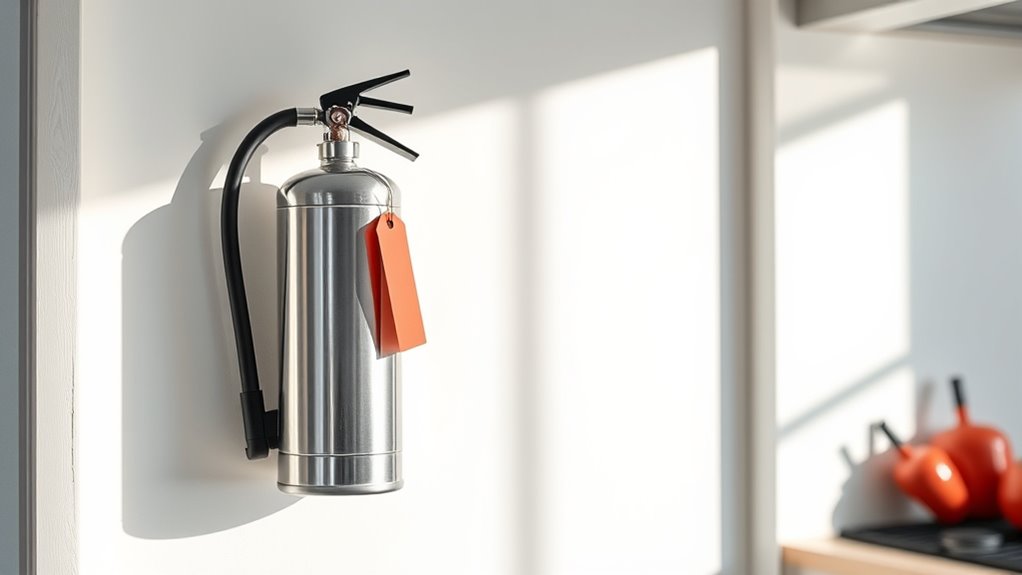
Have you ever wondered how CO2 fire extinguishers work effectively on certain fires? Carbon dioxide is a versatile agent used in fire suppression because it displaces oxygen, starving the fire of the air it needs to burn. When you activate a CO2 extinguisher, the high-pressure gas quickly releases, creating a cold, dense cloud that blankets the flames. This method is particularly effective on electrical fires and flammable liquids, where water or foam might cause further damage or spread the fire. Because CO2 leaves no residue, it’s ideal for sensitive electronics and machinery. Remember, CO2 fire extinguishers are best suited for Class B and electrical fires, making them an essential part of your fire safety kit in areas with electrical equipment. Inspirational quotes about fatherhood can remind us of the importance of protecting loved ones, just as fire safety protects your home and family.
Foam Fire Extinguishers for Flammable Liquids

Foam fire extinguishers are ideal for putting out flammable liquids like gasoline and oil. They work by creating a barrier that smothers the fire, cutting off oxygen. However, it’s important to understand their proper use and limitations to guarantee safety.
Suitable for Liquids
Foam fire extinguishers are highly effective for tackling flammable liquid fires because they form a thick, foam blanket that suppresses vapors and isolates the fuel from oxygen. This makes them ideal for liquid fires involving substances like petrol, oil, and paint. When choosing an extinguisher for liquids, verify its compatibility with the specific type of flammable liquid you might encounter. Foam extinguishers work by smothering the fire and preventing reignition, providing a safe and efficient method to control spills and fires. Always verify that the extinguisher is rated for liquid fires before use. Proper selection ensures effective fire suppression and minimizes damage, protecting both property and lives.
- Suitable for a variety of flammable liquids
- Compatible with different types of liquids
- Prevents reignition by smothering flames
- Easy to identify by rating labels
How Foam Extinguishers Work
When a flammable liquid fire occurs, foam fire extinguishers work by releasing a thick, stable foam that covers the fuel surface quickly. The fire foam composition includes a foaming agent mixed with water and air, creating a frothy, insulating layer. This foam extinguisher mechanics work by smothering the fire, cutting off oxygen supply, and preventing re-ignition. As the foam spreads over the liquid, it cools the fuel and forms a barrier that isolates it from the air. The foam’s stability allows it to cling to surfaces, ensuring extended suppression. This effective method is ideal for flammable liquids like petrol and oils, making foam extinguishers essential in environments with such hazards. Additionally, understanding fire extinguisher types helps in selecting the appropriate device for different fire scenarios.
Usage and Limitations
While foam fire extinguishers are highly effective for suppressing flammable liquid fires, their use has specific limitations you should be aware of. They are not suitable for electrical fires or fires involving reactive chemicals. You must guarantee proper fire extinguisher storage to prevent accidental activation or damage. Inadequate training can lead to ineffective or dangerous use, so fire safety training is essential. Foam extinguishers can also cause the fire to reignite if not used correctly, especially on deep-seated flames. Additionally, the foam can spread flammable liquids if applied improperly. Always keep fire extinguishers accessible and regularly check their pressure and condition. Proper fire extinguisher maintenance and understanding of fire safety principles help ensure safe, effective fire suppression and minimize risks during emergencies.
Wet Chemical Extinguishers for Kitchen Fires
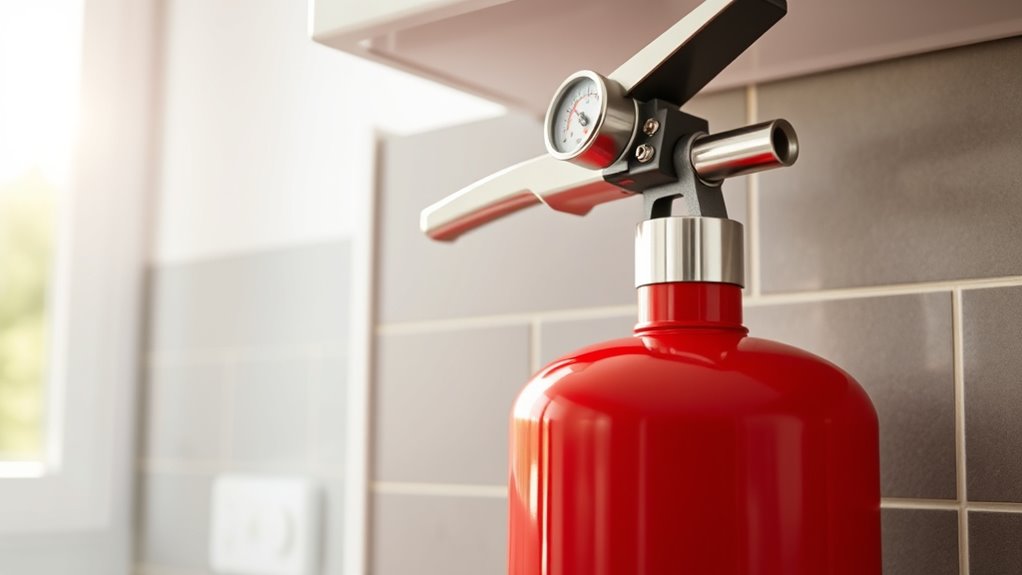
Have you ever wondered how to effectively extinguish a kitchen fire caused by cooking oils or fats? Wet chemical extinguishers are designed specifically for such fires, making them essential for maintaining kitchen safety. These extinguishers use a specialized fire suppressant that reacts chemically with burning fats and oils, forming a soapy layer that cools and smothers the flames. Unlike water-based extinguishers, wet chemical options won’t spread the fire or cause dangerous splattering. They’re easy to operate and highly effective, making them a smart addition to your home safety equipment. Incorporating appropriate fire extinguishers can significantly reduce the risk of fire spreading in the kitchen. By using a wet chemical extinguisher promptly, you can prevent small kitchen fires from escalating, protecting both your home and loved ones from serious damage.
Water Fire Extinguishers and Their Limitations

Are water fire extinguishers suitable for all types of fires? Not quite. They’re mainly effective against Class A fires involving organic materials like wood, paper, or textiles. However, using them on flammable liquids or electrical fires can be dangerous and may worsen the situation. Many fire safety myths suggest water extinguishers are a catch-all solution, but that’s false. They can also cause damage if not disposed of properly; improper extinguisher disposal poses environmental risks. Remember, water extinguishers aren’t versatile for every fire scenario. Always check the label and use the right extinguisher for each fire class. Relying on incorrect assumptions can compromise safety and lead to ineffective firefighting efforts. Stay informed and prioritize proper extinguisher selection and disposal. Additionally, textile materials are generally not suitable for water extinguishers, as they may ignite or smolder further when exposed to water in certain conditions.
Choosing the Right Extinguisher for Different Areas
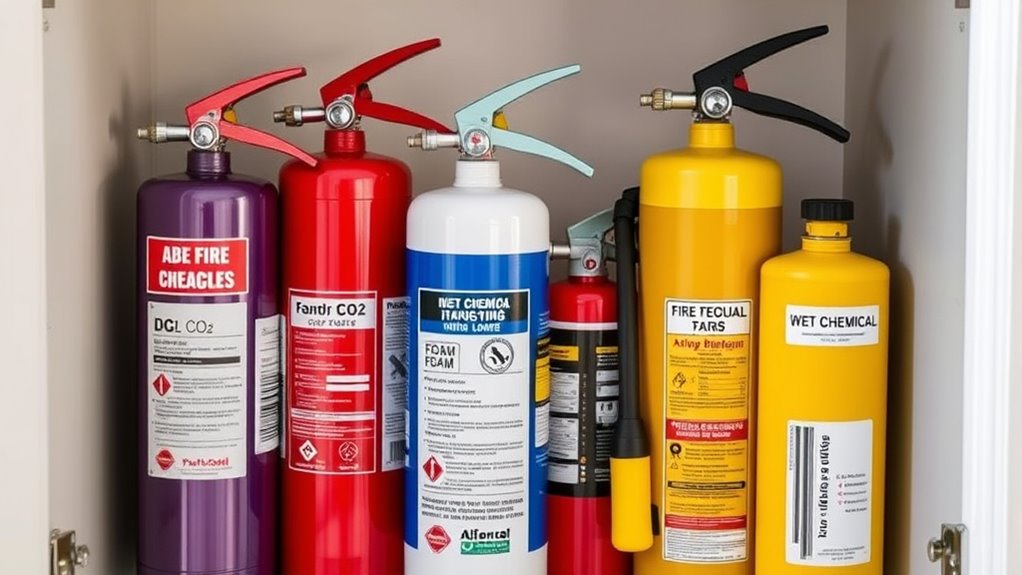
Choosing the right fire extinguisher for different areas is essential to guarantee effective safety measures. Proper fire extinguisher placement ensures quick access during emergencies and enhances homeowner safety. Think about the specific hazards in each area; for example, kitchens need Class K extinguishers for grease fires, while garages benefit from multi-purpose units. To visualize, consider this table:
| Area | Recommended Fire Extinguisher Type |
|---|---|
| Kitchen | Class K (for grease fires) |
| Garage | Multi-purpose (ABC) |
| Living Room | Multi-purpose (ABC) |
| Workshop | CO2 or Dry Chemical |
This approach helps you decide where to place each extinguisher, making your home safer and more prepared. Proper fire extinguisher placement is key to effective homeowner safety, especially when considering fire safety standards.
Proper Use and Maintenance of Fire Extinguishers
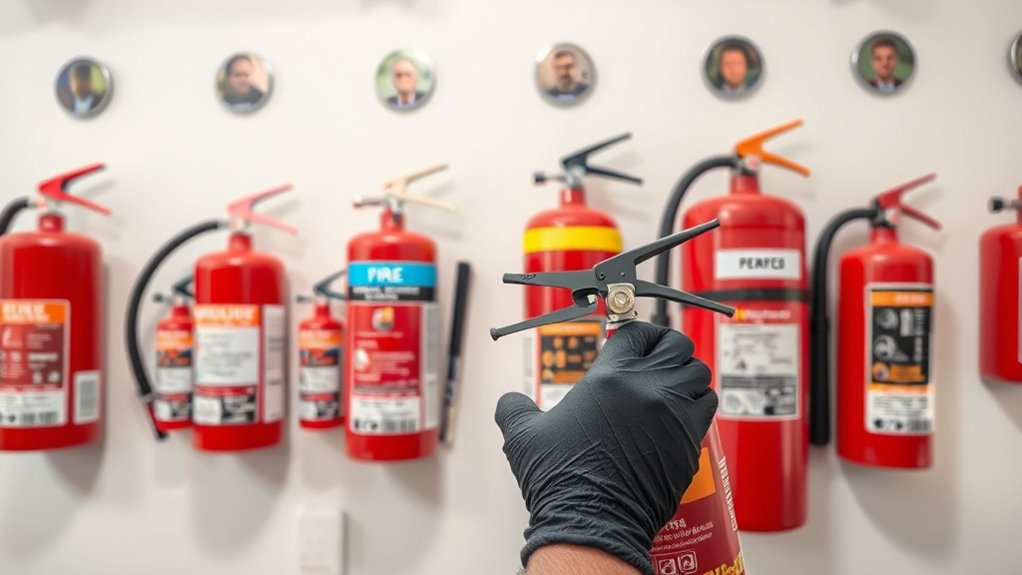
Ever wondered if you’re using your fire extinguisher correctly? Proper use and maintenance are crucial for safety. First, participate in fire extinguisher training to understand how to operate it properly. Regularly check the maintenance checklist to confirm your extinguisher is ready when needed. Keep the pressure gauge in the green zone and inspect for any damage or corrosion. Remember to keep the extinguisher easily accessible and avoid blocking it. Practice the PASS method: Pull, Aim, Squeeze, Sweep. Also, confirm it’s mounted securely and replace or refill after use or if it’s expired. Regular maintenance and training can make all the difference in an emergency, so stay proactive to keep yourself and your home safe.
When to Replace or Refill Your Fire Extinguisher

Knowing when to replace or refill your fire extinguisher is crucial for guaranteeing it functions properly during an emergency. The fire extinguisher lifespan varies depending on the type, but most units need replacement or refill every 5 to 15 years. Check the pressure gauge regularly; if the needle isn’t in the green zone, it’s a clear replacement indicator. Also, look for physical damage like corrosion, leakage, or a cracked cylinder. If your extinguisher has been used, even partially, it must be refilled or replaced immediately. Keep an eye on the manufacturing date and service tags. Proper maintenance and understanding these replacement indicators ensure your fire extinguisher is always ready to perform when needed. Regular inspections are essential for safety and peace of mind.
Frequently Asked Questions
How Often Should Fire Extinguishers Be Inspected?
You should inspect your fire extinguisher regularly to guarantee it’s ready when needed. Follow an inspection schedule of at least once a month, checking the pressure gauge, seals, and nozzle. Use a maintenance checklist to confirm all components are intact and functional. Additionally, have a professional service your extinguisher annually to verify proper maintenance and to address any potential issues. Regular inspections keep your fire safety equipment reliable.
Can Fire Extinguishers Be Used by Untrained Individuals?
Using a fire extinguisher is like riding a bike—possible with some basic knowledge. While untrained individuals can sometimes operate an extinguisher, fire safety training greatly improves your chances of using it effectively. Proper extinguisher operation involves understanding different types and knowing when to use them. If you’re not trained, it’s safer to evacuate and call emergency services instead of risking mishandling. Always prioritize safety first.
Are There Fire Extinguishers Suitable for Electronic Equipment?
Yes, there are electronic specific extinguishers designed for electrical fire suppression. These extinguishers use non-conductive agents, like CO2 or dry chemicals, to safely put out fires involving electronic equipment. If you’re protecting electronics at home, look for extinguishers labeled for electrical fires. Using the right extinguisher guarantees safety and prevents damage, making it easier for you to respond effectively during an electrical fire emergency.
What Is the Lifespan of a Typical Home Fire Extinguisher?
A typical home fire extinguisher lasts about 5 to 15 years, depending on the type and maintenance. Regular fire extinguisher maintenance is essential to guarantee it works when needed. Check the pressure gauge, look for corrosion, and replace or service it as recommended by safety precautions. Keeping track of the expiry date helps maintain safety, so don’t forget to inspect your extinguisher annually.
How Do I Dispose of Expired or Used Fire Extinguishers?
Ever wondered what to do when your fire extinguisher expires? Don’t just toss it in the trash—disposal procedures matter. You should contact local recycling options or fire safety authorities for proper disposal. Many areas have designated drop-off points for hazardous materials. By following these steps, you make certain safety and environmental responsibility. Don’t wait until it’s too late—dispose of your used or expired extinguisher properly today.
Conclusion
Choosing the right fire extinguisher is like planting a sturdy tree in your safety garden—each type guards against different flames, standing ready to protect you. Proper use and maintenance are your watering can, keeping your defenses strong. Remember, fire safety isn’t just about tools; it’s about cultivating awareness. When you’re prepared, you turn a potential inferno into a manageable spark, ensuring your home remains a haven amidst life’s fiery surprises.



